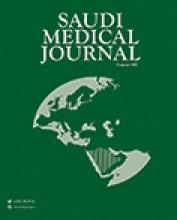Abstract
OBJECTIVE: To evaluate hypersensitivity to Dermatophagoides pteronyssinus (D. pteronyssinus) and D. farinae in pediatric patients with atopic dermatitis (AD), and to assess the therapeutic value of using acaricides with other environmental anti house dust mites (HDM) measures.
METHODS: Ninety-eight children with AD were chosen randomly from the Pediatric Allergy Clinic in Al-Noor Hospital, Khalifa branch, Abu Dhabi, United Arab Emirates during the period between January 2008 to January 2009 and were evaluated for severity and chronicity. They were subjected to skin prick test (SPT) including D. pteronyssinus and D. farinae antigens and were also assessed for the therapeutic value of acaricides and environmental anti HDM measures.
RESULTS: We found that 74.5% of patients were sensitive to one or both strains of HDM. A highly significant association was found between the severity of the symptoms of AD and its persistence with hypersensitivity to HDM (p=0.001). Acaricides and environmental anti HDM measures can improve patients with mild AD.
CONCLUSION: Hypersensitivity to HDM is an important factor for the more acute, more chronic, and more severe AD. Anti HDM measures including the use of acaricides can help control mild AD. We recommend SPT as a part of the work up of patients with AD. The HDM sensitive patients can benefit from anti HDM measures.
- Copyright: © Saudi Medical Journal
This is an open-access article distributed under the terms of the Creative Commons Attribution-Noncommercial License (CC BY-NC), which permits unrestricted use, distribution, and reproduction in any medium, provided the original work is properly cited.






